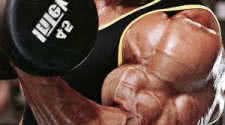Muscle Pump vs No Pump - How to Achieve a Muscle Pump Quickly

Muscular Advancements & Health Sciences
Bodybuilders have been wondering for decades if achieving a pump at every workout is a prerequisite for growth. Most strive for that full, flushed feeling at every session, but just because bodybuilders phase it doesn't mean it's necessary for hyper trophy. Powerlifters rarely get a pump, yet most of them develop immense muscle size. If you look at massive powerlifters, their muscles look somewhat different from those of bodybuilders. Could it be that the lack of a pump in their workouts has something to do with their lack of muscle detail?
It's probably part of the reason.
Of course, most powerlifters aren't ripped to the bone, which accounts somewhat for the quality of their muscularity. Capillarization, or lack of it, is another reason. By not achieving a full-blown pump in each muscle group, powerlifters often fail to develop the intricate capillary network in each bodypart. Their size is primarily a result of fiber hypertrophy, which, by the way, accounts for the majority of muscle size. Nevertheless, developing the capillary network does contribute to muscle size and detail.For one thing, the more capillaries you have in any muscle, the fuller it appears. How much fuller? Perhaps 2 percent, perhaps 5 percent, perhaps 10 percent. It depends on the individual and his or her propensity for this development. Another reason capillarization is important is because the more capillaries there are in a muscle, the more efficient that muscle is at removing waste products and absorbing the nutrients it requires for growth; that is, blood can more easily flow to every part of it. In addition, the more externally vascular a muscle appears, the larger it looks.
Look at some of the male models whose arms are probably in the neighborhood of 15 inches yet appear much larger because of the veins that stand out in bold relief. Capillarization is obviously important to you as a bodybuilding so the next question is how to develop it. One way is to reserve a few weeks of every training cycle for concentrating on muscle pump. This is especially effective if you're on a routine that specifically focuses on fiber hypertrophy, such as a standard two-to-three-days-per- week full-body program that consists of straight sets with heavy weights. On this type of program you do one to two exercises per bodypart and one to two work sets per exercise, which means you probably don't get a full-blown pump at the majority of your workouts.
To develop the capillary network, you can focus on muscle pump after your four-week high-intensity phase is over. For example, take four to six weeks and go all out on all your exercises. After a warmup set or two do one to two straight work sets per exercise until it's impossible to get another rep in good form. This is your high-intensity fast-twitch-fiber-building phase. Now, according to proper phase-training protocol, your body needs time to heal, so you downshift your intensity for one to two weeks.
This downshift doesn't mean you can't focus on capillarization instead of fiber-building intensity. Instead of sticking with straight sets and stopping each set two reps short of positive failure during your two-week medium-intensity phase train for capillarization with drop sets. Here's how to do it. After your standard warmup take the weight that you normally do eight reps with and do six; however, instead of resting, drop the weight by 30 percent and immediately grind out as many reps as you can, then drop the weight again and grind out one last all-out set.
There should be no rest between the three drops. One of these triple drops is probably all you'll need for each exercise, although you may need two for some of your more stubborn bodyparts. Use this drop-set protocol for every exercise in your routine, and you'll achieve a burn and full pump in every target muscle fast. You may be thinking that these drop sets are pretty intense and will defeat the purpose of the medium intensity phase-which is to shore up your recovery ability. After all. two of the three drops are done to failure. But look again.
That's not what happens. The first set is medium intensity and causes lactic acid to pool in the target muscle-so much so, in fact, that you'll hit failure on your second drop set due to muscle burn caused by the influx of more lactic acid, not fiber exhaustion, Ditto for the third set. in essence, you do three back- to-back medium-intensity sets, but you get a skin-stretching pump in the process-which translates into capillary development and not much in the way of recovery-ability depletion.
By the way, even though the pooling of lactic acid makes this medium-intensity work pain Will be involved. Be prepared. Give this drop-set technique a try during your next two-week medium-intensity phase, and watch your muscles pump to the max and eventually take on a new look of vascularity and massiveness.